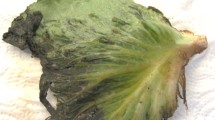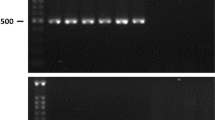Abstract
In August 2010, bacterial soft rot was found on root chicory (Cichorium intybus var. sativum) in Hokkaido, Japan. Severely infected plants in fields were discolored, had wilted foliage, and black necrosis of petioles near the crown. Wilted leaves subsequently collapsed and died, forming a dry, brown or black rosette. The root and crown became partially or wholly soft-rotted. Slimy masses on infected areas of roots, turned dark brown or black. Gram-negative, rod-shaped, peritrichously flagellated, facultatively anaerobic bacteria were exclusively isolated from rotted roots, and typical symptoms were reproduced after inoculation with the strains. The bacteria were identified as Dickeya dianthicola, Pectobacterium carotovorum subsp. carotovorum, and Pectobacterium carotovorum subsp. odoriferum based on further bacteriological characterization and the sequence analysis of the malate dehydrogenase gene and 16S rRNA gene. These bacteria should be included with the previously reported Dickeya (=Erwinia) chrysanthemi in Saitama Prefecture, Japan, as causal pathogens of bacterial wilt of chicory.




Similar content being viewed by others
References
Azegami K, Nishiyama K, Watanabe Y, Suzuki T, Yoshida M, Nose K, Toda S (1985) Tropolone as a root growth-inhibitor produced by a plant pathogenic Pseudomonas sp. causing seedling blight of rice. Ann Phytopathol Soc Japan 51:315–317
Brady CL, Cleenwerck I, Denman S, Venter SN, Rodríguez-Palenzuela P, Coutinho TA, Vos PD (2012) Proposal to reclassify Brenneria quercina (Hildebrand and Schroth 1967) Hauben et al. 1999 into a new genus, Lonsdalea gen. nov., as Lonsdalea quercina comb. nov., descriptions of Lonsdalea quercina subsp. quercina comb. nov., Lonsdalea quercina subsp. iberica subsp. nov. and Lonsdalea quercina subsp. britannica subsp. nov., emendation of the description of the genus Brenneria, reclassification of Dickeya dieffenbachiae as Dickeya dadantii subsp. dieffenbachiae comb. nov., and emendation of the description of Dickeya dadantii. Int J Syst Evol Microbiol 62:1592–1602
Bull CT, de Boer SH, Denny TP, Firrao G, Fischer-Le Saux M, Saddler GS, Scortichini M, Stead DE, Takikawa Y (2010) Comprehensive list of names of plant pathogenic bacteria, 1980–2007. J Plant Pathol 92:551–592
Burkholder WH, McFadden LA, Dimock AW (1953) A bacterial blight of chrysanthemums. Phytopathology 43:522–526
Charkowshi AO (2006) The soft rot Erwinia. In: Gnanamanickam SS (ed) Plant-associated bacteria. Springer, The Netherlands, pp 423–505
De Boer SH, Kelman A (2001) Gram-nagative bacteria, B-2 Erwinia soft rot group. In: Schaad NW, Jones JB, Chun W (eds) Laboratory guide for identification of plant pathogenic bacteria, 3rd edn. APS Press, St Paul, pp 56–72
Dickey RS (1979) Erwinia chrysanthemi: a comparative study of phenotypic properties of strains from several hosts and other Erwinia species. Phytopathology 69:324–329
Gallois A, Samson R, Ageron E, Grimont PAD (1992) Erwinia carotovora subsp. odorifera subsp. nov., associated with odorous soft rot of chicory (Cichorium intybus L.). Int J Syst Bacteriol 42:582–588
Gardan L, Gouy C, Christen R, Samson R (2003) Elevation of three subspecies of Pectobacterium carotovorum to species level: Pectobacterium atrosepticum sp. nov., Pectobacterium betavasculorum sp. nov. and Pectobacterium wasabiae sp. nov. Int J Syst Evol Microbiol 53:381–391
Hauben L, Van Gijsegem F, Swings J (2005) Genus XXIV. Pectobacterium. In: Brenner DJ, Krieg NR, Staley JT, Garrity GM (eds) Bergey’s manual of systematic bacteriology, 2nd edn, vol 2. The proteobacteria, Part B. The Gammaproteobacteria. Springer, New York, pp 721–730
Hélias V, Hamon P, Huchet E, Wolfc JVD, Andrivon D (2012) Two new effective semiselective crystal violet pectate media for isolation of Pectobacterium and Dickeya. Plant Pathol 61:339–345
Kerr EM, Cahill G, Fraser K (2009) Detection of four major bacterial potato pathogens. In: Burns R (ed) Plant pathology, techniques and protocols (Methods in molecular biology, vol 508). Humana Press, New York, pp 101–114
Kikuchi H, Inoue M, Saito H, Sakurai H, Aritsuka T, Tomita F, Yokota A (2009) Industrial production of difructose anhydride III (DFA III) from crude inulin extracted from chicory roots using Arthrobacter sp. H65-7 fructosyltransferase. J Biosci Bioeng 107:262–265
Kimura M (1980) A simple method for estimating evolutionary rate of base substitution through comparative studies of nucleotide sequences. J Mol Evol 16:111–120
Lelliott RA, Dickey RJ (1984) Genus VII. Erwinia. In: Krieg NR, Holt JG (eds) Bergey’s manual of systematic bacteriology, vol 1. Williams and Wilkins, Baltimore, pp 469–476
Ma B, Hibbing ME, Kim HS, Reedy RM, Yedidia I, Breuer J, Breuer J, Glasner JD, Perna NT, Kelman A, Charkowski AO (2007) Host range and molecular phylogenies of the soft rot enterobacterial genera Pectobacterium and Dickeya. Phytopathology 97:1150–1163
Macián MC, Garay E, Pujalte MJ (1996) The arginine dihydrolase (ADH) system in the identification of some marine Vibrio species. Syst Appl Microbiol 19:451–456
Nabhan S, Wydra K (2011) Pathogenicity of soft rot bacteria from potato on tomato plants, and rapid identification and differentiation of the pathogens by restriction fragment length polymorphism. Available at http://www.tropentag.de/2011/abstracts/links/Nabhan_kXmuGJOm.php. Cited 13 August 2012
Nabhan S, Wydra K, Linde M, Debener T (2012) The use of two complementary DNA assays, AFLP and MLSA, for epidemic and phylogenetic studies of pectolytic enterobacterial strains with focus on the heterogeneous species Pectobacterium carotovorum. Plant Pathol 61:498–508
Ngwira N, Samson R (1990) Erwinia chrysanthemi: description of two new biovars (bv 8 and bv 9) isolated from kalanchoe and maize plants. Agronomie 10:341–345
Palacio-Bielsa A, Cambra MA, López MM (2006) Characterisation of potato isolates of Dickeya chrysanthemi in Spain by a microtitre system for biovar determination. Ann Appl Biol 148:157–164
Palacio-Bielsa A, Rodríguez Mosquera ME, Cambra Álvarez MA, Berruete Rodríguez IM, López-Solanilla E, Rodríguez-Palenzuela P (2010) Phenotypic diversity, host range and molecular phylogeny of Dickeya isolates from Spain. Eur J Plant Pathol 127:311–324
Saitou N, Nei M (1987) The neighbor-joining method: a new method for reconstructing phylogenetic tree. Mol Biol Evol 4:406–425
Sakai K (1995) Occurrence of bacterial wilt disease of chicory, Chichorium intybus L., and control experiments by chemicals (in Japanese). Ann Rept Kanto-Tosan Plant Prot Soc 42:55–57
Samson R, Poutier F, Sailly M, Hingand L, Jouan B (1980) Bactéries associées å une pourriture du collet de l’endive (in French). Ann Phytopathol 12:311–317
Samson R, Poutier F, Sailly M, Jouan B (1987) Caractérisation des Erwinia chrysanthemi isolées de Solanum tuberosum et d’autres plantes-hôtes selon les biovars et sérogroupes. EPPO Bull 17:11–16
Samson R, Legendre JB, Christen R, Fischer-Le Saux M, Achouak W, Gardan L (2005) Transfer of Pectobacterium chrysanthemi (Burkholder et al. 1953) Brenner et al. 1973 and Brenneria paradisiaca to the genus Dickeya gen. nov. as Dickeya chrysanthemi comb. nov. and Dickeya paradisiaca comb. nov. and delineation of four novel species, Dickeya dadantii sp. nov., Dickeya dianthicola sp. nov., Dickeya dieffenbachiae sp. nov. and Dickeya zeae sp. nov. Int J Syst Evol Microbiol 55:1415–1427
Shin SY, Lee MY, Song JH, Ko KS (2008) New Erwinia-like organism causing cervical lymphadenitis. J Clin Microbiol 46:3156–3158
Sławiak M, van Beckhoven JRCM, Speksnijder AGCL, Czajkowski R, Grabe G, van der Wolf JM (2009) Biochemical and genetical analysis reveal a new clade of biovar 3 Dickeya spp. strains isolated from potato in Europe. Eur J Plant Pathol 125:245–261
Toth IK, van der Wolf JM, Saddler G, Lojkowska E, Hélias V, Pirhonen M, Tsror (Lahkim) L, Elphinstone JG (2011) Dickeya species: an emerging problem for potato production in Europe. Plant Pathol 60:385–399
Acknowledgments
The authors are grateful to the Institute of Nippon Beet Sugar Manufacturing for providing chicory samples. Regional Innovation Strategy Support Program from Ministry of Education, Culture, Sports, Science and Technology, Japan supported this study.
Author information
Authors and Affiliations
Corresponding author
Electronic supplementary material
Below is the link to the electronic supplementary material.
Rights and permissions
About this article
Cite this article
Lan, W.W., Nishiwaki, Y., Akino, S. et al. Soft rot of root chicory in Hokkaido and its causal bacteria. J Gen Plant Pathol 79, 182–193 (2013). https://doi.org/10.1007/s10327-013-0440-z
Received:
Accepted:
Published:
Issue Date:
DOI: https://doi.org/10.1007/s10327-013-0440-z




